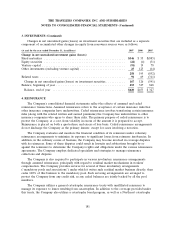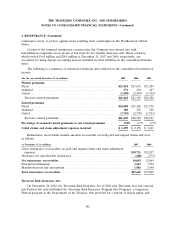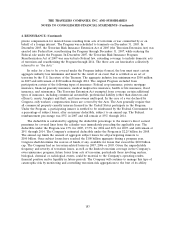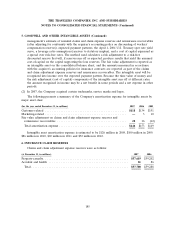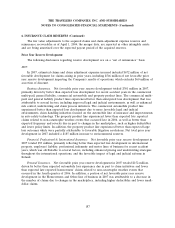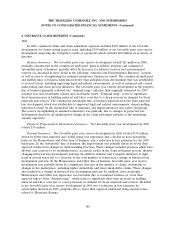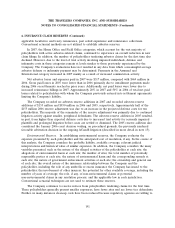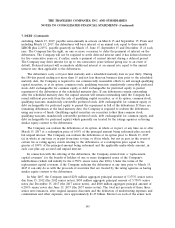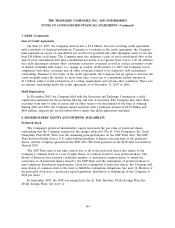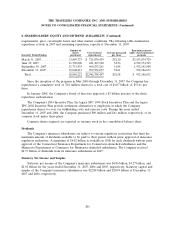Travelers 2007 Annual Report Download - page 203
Download and view the complete annual report
Please find page 203 of the 2007 Travelers annual report below. You can navigate through the pages in the report by either clicking on the pages listed below, or by using the keyword search tool below to find specific information within the annual report.THE TRAVELERS COMPANIES, INC. AND SUBSIDIARIES
NOTES TO CONSOLIDATED FINANCIAL STATEMENTS (Continued)
6. INSURANCE CLAIM RESERVES (Continued)
applicable facultative and treaty reinsurance, past ceded experience and reinsurance collections.
Conventional actuarial methods are not utilized to establish asbestos reserves.
In 2007, the Home Office and Field Office categories, which account for the vast majority of
policyholders with active asbestos-related claims, continued to experience an overall reduction in new
claim filings. In addition, the number of policyholders tendering asbestos claims for the first time also
declined. However, due to the level of trial activity involving impaired individuals, defense and
indemnity costs in these categories remain at levels similar to those previously experienced by the
Company. The Company’s evaluations have not resulted in any data from which a meaningful average
asbestos defense or indemnity payment may be determined. Payments in the Assumed and
International category increased in 2007 mainly as a result of increased commutation activity.
Net asbestos losses and expenses paid in 2007 were $317 million, compared with $469 million in
2006. Gross paid losses in 2007 were lower than in 2006 primarily due to installment payments made
during 2006 on settlements reached in prior years. Additionally, net paid losses were lower due to
increased reinsurance billings in 2007. Approximately 20% in 2007 and 50% in 2006 of total net paid
losses related to policyholders with whom the Company previously entered into settlement agreements
limiting the Company’s liability.
The Company recorded no asbestos reserve additions in 2007 and recorded asbestos reserve
additions of $155 million and $830 million in 2006 and 2005, respectively. Approximately half of the
$155 million 2006 reserve adjustment was due to an increase in the projected defense costs for ten
policyholders. The majority of the remainder of the reserve adjustment was primarily due to continued
litigation activity against smaller, peripheral defendants. The asbestos reserve addition in 2005 resulted,
in part, from higher than expected defense costs due to increased trial activity for seriously impaired
plaintiffs and prolonged litigation before cases are settled or dismissed. The 2005 reserve addition also
considered the January 2006 court decision voiding, on procedural grounds, the previously rendered
favorable arbitration decision in the ongoing ACandS litigation (described in more detail in note 15).
Environmental Reserves. In establishing environmental reserves, the Company evaluates the
exposure presented by each policyholder and the anticipated cost of resolution, if any. In the course of
this analysis, the Company considers the probable liability, available coverage, relevant judicial
interpretations and historical value of similar exposures. In addition, the Company considers the many
variables presented, such as the nature of the alleged activities of the policyholder at each site; the
allegations of environmental harm at each site; the number of sites; the total number of potentially
responsible parties at each site; the nature of environmental harm and the corresponding remedy at
each site; the nature of government enforcement activities at each site; the ownership and general use
of each site; the overall nature of the insurance relationship between the Company and the
policyholder, including the role of any umbrella or excess insurance the Company has issued to the
policyholder; the involvement of other insurers; the potential for other available coverage, including the
number of years of coverage; the role, if any, of non-environmental claims or potential
non-environmental claims in any resolution process; and the applicable law in each jurisdiction.
Conventional actuarial techniques are not used to estimate these reserves.
The Company continues to receive notices from policyholders tendering claims for the first time.
These policyholders generally present smaller exposures, have fewer sites and are lower tier defendants.
Further, in many instances clean-up costs have been reduced because regulatory agencies are willing to
191


